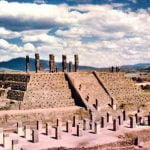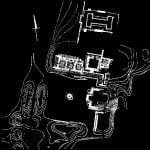
The Toltecs are associated with a single city, about 100 miles north of Mexico City. It is known today by the Totonac word for town, Tula. However, that was also the probable name of Teotihuacan. The city probably had another name. The problem is now, anthropologists are not even sure what ethnic group lived there. The city was contemporary with the Totonac and Huastec civilizations, but its architecture bears no resemblance to either. What the architecture of Tula No. 2 does resemble is the Native American city in southern Illinois now called Cahokia. Tula’s pyramids are earth and rubble veneered with stone and plaster, while Cahokia’s pyramids were all earthen.
Scholars long assumed that the Aztec version of history, in regard to the Toltecs, was accurate. These Aztecs stated that the Toltecs were originally Chichimec barbarians like themselves, who eventually became great artisans and scholars. The word means “artisans” in Archaic Nahuatl.
Toltec civilization did not quite have the sophistication of the Mayas. The final form of its architecture was simpler and more martial in appearance than that of the Mayas. The Toltecs utilized a logoglyphic writing system that probable was incapable of transmitting complete sentences or verb tenses.
According to several Mesoamerican legends, Tula was founded around 900 AD by newcomers to its region. Neighboring provinces tried to drive the newcomers out. In the Nahuatl version, Cē Ācatl Topiltzin (Our Prince One-Reed Feathered Serpent) was born in the city of Tepotzlan, but as a young man migrated to Tula. Here he worked his way up the ranks of the military until becoming the king. Once in power, he became a peace-loving priest king, who abolished human sacrifice and replaced Tula’s pantheon with a single god, Quetzalcoatl. At this time, Quetzalcoatl (or Kukulkan in Maya) was worshiped as the God of the Wind, Merchants and Dawn. He was the principal deity of the Itza Mayas, who portrayed him as a snake with feathers.

Interpretations by some scholars place Topiltzin’s reign at approximately 923 AD to 947 AD. Scholars are unsure because the calendars used in north central Mexico were not nearly as precise as the Maya calendar. The dates seem to early to jive with the versions of the legend in southern Vera Cruz and the Yucatan Peninsula. All legends agree that his reign ended when a militaristic clique carried out a coup d’etat. The worship of Quetzalcoatl was abandoned and the city returned to its warlike pantheon.
In the most well known legend, Topiltzin, sailed into the Gulf of Mexico with his followers to Tlillan-Tlapallan (Place of the black and red color in Nahuatl) on another shore of the Gulf Coast of Mexico. Before departing, he promised to return some day, but didn’t.
A version of this legend among the Jarocho People of southern Vera Cruz is that Topiltzin first sailed down the coast to Coatzacoalcos in southern Vera Cruz. Coatzacoalcos means “Place of the Snake” or “Place where the snake hides” in Nahuatl. From there he and his followers sailed north across the Gulf of Mexico to Tlillan-Talpallan. The Jarocho version places his departure in the year 999.

The Yucatec Maya version of the legend states that Topiltzin stayed in Coatzacoalcos for a period of time then sailed to the northern Yucatan peninsula. There he and his followers settled in Chichen Itza and introduced their religious beliefs. There IS architectural evidence of a Toltec cultural influence in Chichen Itza. The Temple of the Warriors in Chichen Itza is virtually identical to the Temple of the Warriors in Tula. In the Yucatec version, Topiltzin eventually sailed due north in 999 AD with some of his followers from the port of Isla de Cerritos to a land on the other side of the Gulf of Mexico. If one sails due north from Isla Cerritos, the ship will eventually land at Mobile Bay, the outlet for the Mobile River.
Mesoamerican and North American legends cannot be assumed to be factual. However, invariably the legend is derived from some real historical event in the distant past. The legend of Topiltzin is particularly relevant to the Track Rock Terrace Complex for many reasons.
- The largest tributary of the Mobile River is the Coosa River. The primary source of the Coosa River is on the slopes of Coosa Bald Mountain in Union County, GA – due west of Track Rock Gap.
- The priestly clan of the Creek Indians is the Wind Clan. Quetzalcoatl was the God of the Wind.
- Creek chokopa’s or conical-shaped council houses were identical in construction and shape to the folk temples erected by Chontal Maya merchants to Kukulkan (Quetzalcoatl.)
- A large fieldstone snake effigy was built on the acropolis of the Track Rock terrace complex. An identical fieldstone snake effigy is on Dug Out Mountain, 55 miles due west of the one at Track Rock.
- Even today, the feathered serpent is a common artistic motif among the Creek Indians.
- Cherokee legends describe a great stone temple at the top of a mountainside city with a snake idol in it. The Cherokee legends called this city, “the capital of the Creek Indians.”
- On Boulder Six of the Track Rock petroglyphs are four common Maya glyphs, which mean “Mako hene ~ ahau Kukulkan” or “Great Sun (King) Quetzalcoatl.”
